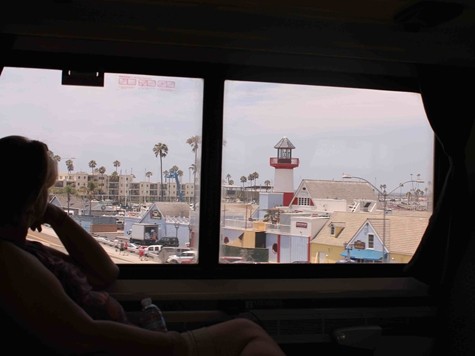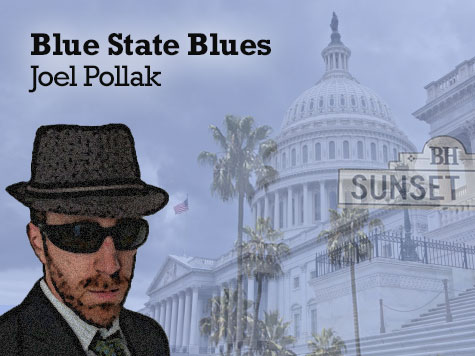(6:30 a.m.) For the past 24 hours, I have been on the move. Early Thursday morning, a colleague picked me up at home and we drove south to Anaheim on the I-405 and CA-22. We caught Amtrak’s Pacific Surfliner to Solana Beach, then took an Uber south to La Jolla on I-5. We did the same in reverse, whereupon she drove me to Long Beach Airport. I caught the 3:15 JetBlue flight to Oakland, took the BART to San Francisco, then took the overnight Greyhound back to L.A.
Along the way, I was able–thanks to a portable Verizon WiFi device (though no thanks to a faulty WiFi system on the overnight Greyhound bus)–to dole out assignments for Breitbart California, write two news articles (one on foreign policy and one on the Supreme Court decision in NLRB v. Noel Canning), conduct an interview with Texas Gov. Rick Perry, write up that interview, cover a panel discussion on gay marriage, edit several other pieces, and sleep.

View from the Pacific Surfliner
The total transportation cost for the trip, for me, was roughly $325. That’s not bad, considering I visited at least five major cities and took in a bit of scenery along one of the world’s most magnificent coastlines.
Perhaps high-speed rail, had it existed, might have cut an hour or two out of the journey. I doubt that it would have been cheaper, or–and this is crucial–that it would have been more convenient. Essentially, high-speed rail is a pricey solution in search of a problem.
That is especially clear in light of the fact that we do not currently have a reliable “low-speed” rail connection between downtown Los Angeles and downtown San Francisco. The only option for direct overland travel is a bus, or a train in combination with a bus, or two trains (Amtrak and Caltrain) with bus connections. It seems that a normal rail connection between the two cities might be a more realistic, less costly, and ultimately useful public transportation goal.
Yet perhaps the goal of high-speed rail is something other than connecting one place to another. The proposal, as described by Gov. Brown at his most enthusiastic, has two main benefits.
One is that high-speed rail will show that the United States can still do great things–that we can achieve feats of engineering and planning as ambitious as those of the Japanese in the 1970s (whose own train first inspired Gov. Brown on a visit there) or the Chinese state of today.
The other goal is to save the planet from climate change by removing cars from the road and moving people across the country in more energy-efficient ways. Some environmentalists are unsure that the high-speed rail project will, on balance, save energy. Yet the idea seems to be that this mass transit project will inspire others across the country and across the world, that it will achieve by example to others what it may fail to do in its own particular, individual case.
Both of the above arguments amount to an aesthetic defense of high-speed rail, not actually an environmental case (still less an economic one). The idea of high-speed rail makes some of us feel good; therefore we must build it. It is essentially the world’s most expensive amusement ride, which is why the proposal once bandied about to build a high-speed rail link between Disneyland and Las Vegas might have been the best version of the plan devised thus far.
But there is probably more carbon saved–in case you’re worried–in an electric car than in an expensive public works project. There is probably just as much convenience in a WiFi-equipped airplane, train or bus. And California is so beautiful–why would you want to speed through it?
If I were GOP gubernatorial candidate Neel Kashkari, I would focus on the “crazy train” alone–the only one on which voters side with him against a governor they otherwise like.

COMMENTS
Please let us know if you're having issues with commenting.